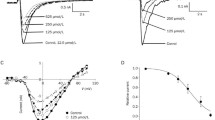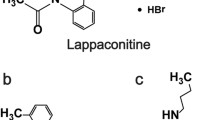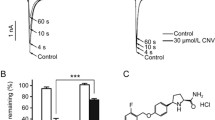Abstract
Articaine is widely used as a local anesthetic (LA) in dentistry, but little is known regarding its blocking actions on Na+ channels. We therefore examined the state-dependent block of articaine first in rat skeletal muscle rNav1.4 Na+ channels expressed in Hek293t cells. Articaine exhibited a weak block of resting rNav1.4 Na+ channels at −140 mV with a 50% inhibitory concentration (IC50) of 378 ± 26 μM (n = 5). The affinity was higher for inactivated Na+ channels measured at −70 mV with an IC50 value of 40.6 ± 2.7 μM (n = 5). The open-channel block by articaine was measured using inactivation-deficient rNav1.4 Na+ channels with an IC50 value of 15.8 ± 1.5 μM (n = 5). Receptor mapping demonstrated that articaine interacted strongly with a D4S6 phenylalanine residue, which is known to form a part of the LA receptor. Thus the block of rNav1.4 Na+ channels by articaine is via the conserved LA receptor in a highly state-dependent manner, with a ranking order of open (23.9×) > inactivated (9.3×) > resting (1×) state. Finally, the open-channel block by articaine was likewise measured in inactivation-deficient hNav1.7 and rNav1.8 Na+ channels, with IC50 values of 8.8 ± 0.1 and 22.0 ± 0.5 μM, respectively (n = 5), indicating that the high-affinity open-channel block by articaine is indeed preserved in neuronal Na+ channel isoforms.








Similar content being viewed by others
References
Abrahamsen B, Zhao J, Asante CO et al (2008) The cell and molecular basis of mechanical, cold, and inflammatory pain. Science 321:702–705
Ahern CA, Eastwood AL, Dougherty DA, Horn R (2008) Electrostatic contributions of aromatic residues in the local anesthetic receptor of voltage-gated sodium channels. Circ Res 102:86–94
Aldrich RW, Corey DP, Stevens CF (1983) A reinterpretation of mammalian sodium channel gating based on single channel recording. Nature 306:436–441
Borchard U, Drouin H (1980) Carticaine: action of the local anesthetic on myelinated nerve fibres. Eur J Pharmacol 62:73–79
Catterall WA (2000) From ionic currents to molecular mechanisms: the structure and function of voltage-gated sodium channels. Neuron 26:13–25
Catterall WA, Mackie K (2001) Local anesthetics. In: Hardman JG, Limbird LE, Molinoff PB, Ruddon RW, Gilman AG (eds) Goodman & Gilman’s The pharmacological basis of therapeutics. Macmillan, New York, pp 367–384
Cota G, Armstrong CM (1989) Sodium channel gating in clonal pituitary cells: the inactivation step is not voltage dependent. J Gen Physiol 94:213–232
Cox JJ, Reimann F, Nicholas AK et al (2006) An SCN9A channelopathy causes congenital inability to experience pain. Nature 444:894–898
Hamill OP, Marty E, Neher ME, Sakmann B, Sigworth FJ (1981) Improved patch-clamp techniques for high-resolution current recording from cells and cell-free membrane patches. Pflugers Arch 391:85–100
Hille B (1977) Local anesthetics: hydrophilic and hydrophobic pathways for the drug receptor reaction. J Gen Physiol 69:497–515
Hille B (2001) Classical mechanisms of block. In: Ion channels of excitable membranes. Sinauer Associates, Sunderland, MA, pp 503–536
Jeske AJ, Blanton PL (2006) Selection of local anesthetics in dentistry: clinical impression versus scientific assessment. J Am Coll Dent 73:21–24
Leffler A, Reiprich A, Mohapatra DP, Nau C (2007) Use-dependent block by lidocaine but not amitriptyline is more pronounced in tetrodotoxin (TTX)-resistant Nav18 than in TTX-sensitive Na+ channels. J Pharmacol Exp Ther 320:354–364
Lipkind GM, Fozzard HA (2005) Molecular modeling of local anesthetic drug binding by voltage-gated Na channels. Mol Pharmacol 68:1611–1622
Luo S, Perry GM, Levinson SR, Henry MA (2008) Nav17 expression is increased in painful human dental pulp. Mol Pain 4:16
Nau C, Wang GK (2004) Interactions of local anesthetics with voltage-gated Na+ channels. J Membr Biol 201:1–8
Ragsdale DS, McPhee JC, Scheuer T, Catterall WA (1994) Molecular determinants of state-dependent block of Na+ channels by local anesthetics. Science 265:1724–1728
Schulze KE, Cohen PR, Nelson BR (2006) Articaine: an effective adjunctive local anesthetic for painless surgery at the depth of the muscular fascia. Dermatol Surg 32:407–410
Schwarz W, Palade PT, Hille B (1977) Local anesthetics: effect of pH on use-dependent block of sodium channels in frog muscle. Biophys J 20:343–368
Starmer CF, Grant AO, Strauss HC (1984) Mechanisms of use-dependent block of sodium channels in excitable membranes by local anesthetics. Biophys J 46:15–27
Tikhonov DB, Bruhova I, Zhorov BS (2006) Atomic determinants of state-dependent block of sodium channels by charged local anesthetics and benzocaine. FEBS Lett 580:6027–6032
Wang S-Y, Bonner K, Russell C, Wang GK (2003) Tryptophan scanning of D1S6 and D4S6 C-termini in voltage-gated sodium channels. Biophys J 85:911–920
Wang S-Y, Mitchell J, Moczydlowski E, Wang GK (2004) Block of inactivation-deficient Na+ channels by local anesthetics in stably transfected mammalian cells: evidence for drug binding along the activation pathway. J Gen Physiol 124:691–701
Warren CA, Mok L, Gordon S, Fouad AF, Gold MS (2008) Quantification of neural protein in extirpated tooth pulp. J Endod 34:7–10
Zhao J, Ziane R, Chatelier A, O’leary M, Chahine M (2007) Lidocaine promotes the trafficking and functional expression of Nav18 sodium channels in mammalian cells. J Neurophysiol 98:467–477
Acknowledgments
This work was supported by National Institutes of Health Grant GM48090. We are grateful to Dr. Edward Moczydlowski for the HEK293 cell line expressing wild-type rNav1.4 channels and to Drs. James Trimmer, Norbert Klugbauer, and John Wood for the rNav1.4, hNav1.7, and rNav1.8 cDNA clones, respectively.
Author information
Authors and Affiliations
Corresponding author
Rights and permissions
About this article
Cite this article
Wang, G.K., Calderon, J., Jaw, SJ. et al. State-Dependent Block of Na+ Channels by Articaine Via the Local Anesthetic Receptor. J Membrane Biol 229, 1–9 (2009). https://doi.org/10.1007/s00232-009-9170-8
Received:
Accepted:
Published:
Issue Date:
DOI: https://doi.org/10.1007/s00232-009-9170-8




